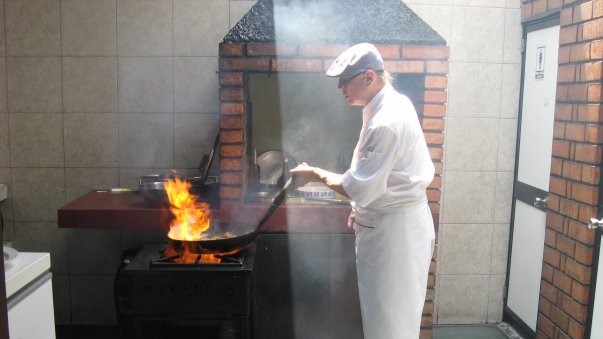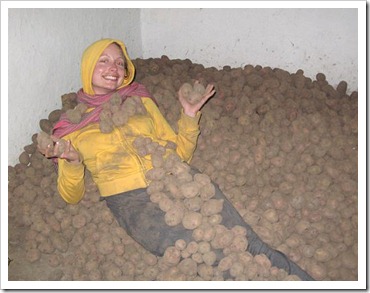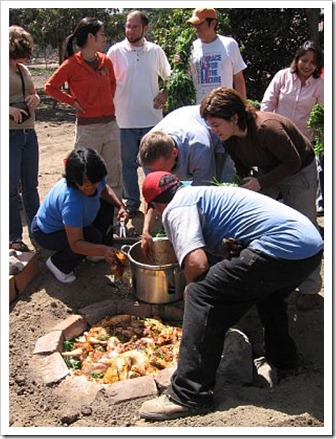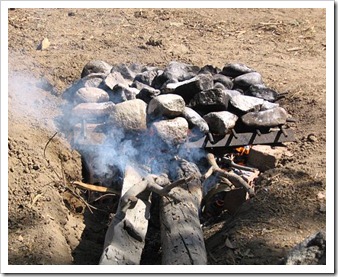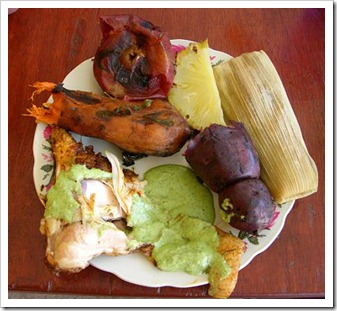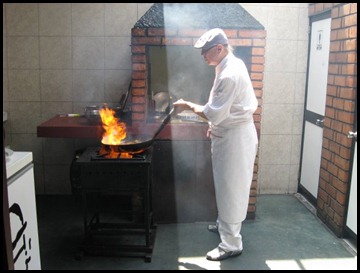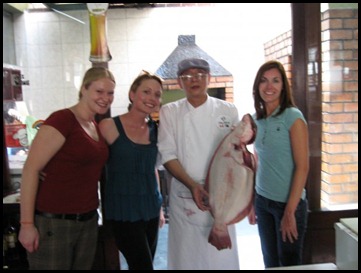In June of 2006, I packed my bags and headed to Peru for what was supposed to be a two year stint. Not long after my arrival, Peruvian cuisine kidnapped me and proceeded to hold me hostage for five entire years. I have narrowly escaped her death grip more than once to flee to my native country, but Stockholm syndrome in the form of ceviche cravings has sent me running back to her lap time and time again. It’s hopeless, for I’m like putty in her hands. I took the challenge to find the best restaurants in Lima.
People sometimes refer to Peru as the land of the potato, but I hesitate to pigeonhole such a diverse country in that fashion (See? There I go defending my captor again!). Yes, Peru is home to approximately 4,000 varieties of potatoes (that’s no exaggeration), and yes, one time I stumbled upon an entire bedroom FULL of potatoes in my host family’s house (please refer to Exhibit A), but this doesn’t mean that potatoes are all Peru has to offer, nor does it mean that their prevalence in any way correlates with my inability to terminate my time here.
I can pinpoint the exact moment that Peruvian food wiled me into her bosom. My organization arranged a series of activities to introduce us to Peruvian culture, one of which was the elaboration of a pachamanca. “Pacha” is Quechua for earth and “manca” means cooking pot, so “pachamanca” loosely translates to earth oven. To create a pachamanca, rounded volcanic rocks are baked over a fire for an hour before being strategically layered in a pit with chicken, beef, pork, fruits, potatoes, beans, humitas (sweet corn tamales), and highland herbs. The burial of the food in the ground serves as an offering to pachamama, or mother earth, for the abundant harvest she provides for us. After about three hours, the heat from the rocks has cooked all of the pit’s contents to perfection, and each layer of ingredients is ceremoniously unveiled and arranged on a plate to be eaten. The pachamanca is a ritual that pre-dates the Incas, and to this day it remains a celebration of community, teamwork, nature, and life for Peruvian people.
This is the pachamanca that we built, followed by our final product. In case you were wondering, the plate of food shown was inhaled by yours truly in an impressive 45 seconds:
To be honest, I didn’t think I’d enjoy the pachamanca experience as much as I did. I don’t like waiting for my food, and three hours seems like an eternity when you are what can only be described as a perpetually starving beast. However, when the food met my mouth, I was truly moved. The deliciously smoky taste and tender texture of the meat was the perfect reward for a whole morning spent collaborating to prepare the food and pit. The hot rocks had crisped the outer layer of all of the meats and fruits, helping to contain their juices and accentuate their natural flavors. The sweet potato and baked apple melted in my mouth, and their explosive taste made it really hard to believe that I was eating healthy. Throughout the process, I learned just how much Peruvians value their food and the experience of eating it together. I have essentially spent the last five years bonding with them over our mutual appreciation of all things edible. It has been nothing short of a mouth-watering blast, and I thank my lucky stars every day to have had (and still be having) the experience.
So now you know how my “abduction” unfolded, and I suppose I wouldn’t be offended if you suggested that I was a willing participant;).
Pachamanca is just one of Peru’s many culinary treasures. Each region of the country offers new flavors, and I strongly believe that Peru’s gastronomy is enough of a reason to visit the country/stay here forever (Machu Picchu? What’s that?). From Piuran seco de cabrito (a piquant goat and bean dish), to Arequipan rocoto relleno (hot peppers stuffed with meat, onions, egg, and cheese), to jungle juanes (a chicken and rice dish that is boiled and served in a banana leaf), it’s impossible to disappoint your palate. Come one, come all, there’s enough food for everyone (if I stop eating it all, that is)!
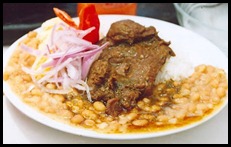 |
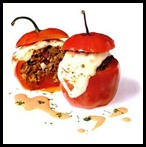 |
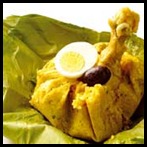 |
In honor of my five year anniversary with Peru, I would like to use this entry to begin showcasing what I consider to be the best restaurants in Lima. Phenomenal food can be found in all parts of Peru, but since this is a blog and not a book, I am limiting this entry to Lima, where I have resided for the last three years. Today, I will highlight Lima’s best appetizers, ceviche, sandwiches, and anticuchos. My next post will address main dishes, desserts, drinks, and best overall dining experiences. If you’re wondering what qualifies me to be the judge of all of these things, I will proffer the following information: I spend 95% of my salary on food. The other 5% is spent on transportation costs involved in foraging for more food. I rarely revisit restaurants, and I have chowed down in so many eateries that it is a challenge to locate new ones. Sometimes my friends recommend places to me, and I get all the way to the restaurant before realizing that I have already eaten there (ahhhh, the trials and tribulations of being a foodie!). Do I really need to convince you at this point that I know my food, though? I started a whole blog revolving around it for Pete’s sake.
Let’s get started!
Best Appetizer: Like you’ll find in many of the following categories, this was a three-way tie. These ties do not stem from any indecisiveness on my part, but instead, from the fact that there is a ridiculous amount of excellent food in Lima. Go to Cebicheria Chulucanas (Bernardo Alcedo 540, Lince) for their tamal verde. This is a cilantro-infused corn tamale, topped with sauce from their exquisite seco de cabrito dish. It’s out of this world, and the ambiance is pleasing to boot. This breezy restaurant transports you to Piura with it’s nautical theme, relaxed atmosphere, and live coastal music. The owner is friendly and may even invite himself to a seat at your table to learn more about you. Don’t fret, his company is a true treat. Thanks to Luis Ly for talking about food with me ALL the time, and recommending this diamond in the rough (of Lince).
Another “best appetizer” can be found at Pescados Capitales. Order the wantanes capitales, which are wantons that are generously stuffed with ceviche (raw fish marinated in lime juice with chili pepper) served with creamy aji sauce. This restaurant’s innovative menu and website are brimming with crafty wordplay and roguish dancing fish and lobsters. I commend the people responsible for their attention to such charming details.
Last but not least, check out the encamotao at Madam Tusan (Santa Cruz 858, Miraflores). These are succulent shrimp and chicken dumplings that are coated with toasted sweet potato strips. Madam Tusan is a Chinese-Peruvian fusion restaurant that is the latest culinary undertaking of Gaston Acurio (Peru’s most famous chef). More on him later.
Onto our next category of Best Ceviche: This was a tough decision for two reasons: 1. Ceviche is my favorite Peruvian food, so I eat a ton of it, and 2. Lima is on the coast, so decent ceviche restaurants are ever-present. Somehow (perhaps because it’s all I think about), I managed to narrow it down to four dishes. For a more traditional and simple ceviche, visit Chez Wong (Enrique Leon Garcia 114, La Victoria), but be prepared to dish out a bit more money than you may be used to spending in Peru. Chef Wong is one of Lima’s celebrity chefs, and he runs a 7-table rather austere restaurant (that may also be his house) in a sketchy part of town. It is one of Lima’s more interesting restaurants in the sense that there is no menu (Chef Wong himself might visit your table to ask you nothing more than, “salty or sweet?” before whipping up something special for you), and he prepares everything right there in front of you. This involves using huge knives to gut and chop fresh fish, which provides quite the show, and he is QUITE the character. His food speaks for itself and after you taste it, it comes as no surprise that the restaurant is consistently jam-packed (be sure to reserve your table weeks ahead of time). His ceviche mixto is the freshest and most flavorful I have ever tasted, which compensates for what some consider to be a lack of ambiance in his restaurant.
The other three ceviche dishes that win the award for “best ceviche” are variations of the traditional dish. Fiesta Restaurant Gourmet (Avenida Reducto 1278, Miraflores) has a ceviche caliente that challenges the notion that ceviche should be served chilled. The heat intensifies the flavor while not at all subtracting from its freshness. Alfresco (Malecon Balta 740, Miraflores) serves a ceviche nikkei, in which raw salmon and tuna are marinated in an Asian-inspired sweet and sour sauce. Truly. Divine. The aforementioned plates are a bit on the pricey side, so I would have to vote this next ceviche as that which gives you the most bang for your buck. One time when I was trapped in Bolivia, I even shed tears over how much I missed el ceviche a la diabla from El Mordisco. This ceviche consists of all different types of seafood marinated in a creamy leche de tigre (a spicy fish-infused lime juice that is so delicious that people drink it plain by the cupful), chopped up and stuffed into squid. I’ve never tasted anything like it, and if you asked me to pick my last meal at this very instant, ceviche a la diabla just might be it.
Best Sandwich: I hail from the land of cheesesteaks and hoagies, so I am pretty particular when it comes to sandwiches. Peruvians are not huge on sandwiches, but I have located a couple in the most unlikely places that I absolutely adore. Big ups to Luis Tenorio for introducing me to Sandwiches Monstruos (Avenida Nicolas de Pierola 113, Barranco). This small establishment has been churning out tasty sandwiches for decades, and what it lacks in seating, it makes up for in fresh meats, breads, and condiments. Order the sandwich de jamon serrano with salsa criolla, tartara, y aji. Great, now my mouth is watering. My other favorite sandwich can strangely enough be found at what some might consider a fast-food restaurant. Pasquale Hermanos makes a sandwich of lomo saltado, which is a traditional Peruvian dish of sautéed beef, onions, tomatoes, and soy sauce. Usually it is served over rice, but I am not sure why it hasn’t caught on more in sandwich form. Yum. Yum. Yum. Make sure to experiment with all of the sauces that are offered.
Best Anticucho: What’s an anticucho? Well, I was recently scolded for explaining this to someone because apparently you are supposed to let people taste it before telling them what it really is. I missed that memo, so I’ll let you in on the secret. Anticucho is skewered cow heart, which is a beloved street food in Peru that you should definitely give a chance. Here is one of the first conversations I had in Peru:
Friend: Do you like anticuchos?
Me: What’s that?
Friend: Grilled cow hearts.
Me: Ew. No.
Friend: Why did you eat three plates of them on our first night here then?
Me: (Looooooooong pause) I thought they were kabobs of filet mignon. Damn it.
I believe the secret to a good anticucho is that it should just taste like regular meat. I think that Del Carajo achieves this. Their servings are a bit small, but they are impeccably marinated and grilled, and they accompany a great Afro-Peruvian music and dance show. My other favorite anticucho is made with octopus instead of cow heart. This is not a common variation, so the anticucho de pulpo makes a visit to Panchita (Avenida Dos de Mayo 298, Miraflores) well worth it. It is the only octopus dish I have ever tried that I wouldn’t describe as “chewy.” If I could think of another word for tender, I would definitely use it here. And you should definitely go to Panchita.
We will stop here for now. If you are in Peru, check out what I consider to be the best restaurants in Lima. If you are not, you should be. Until you are, I’ll eat enough for the both of us!

